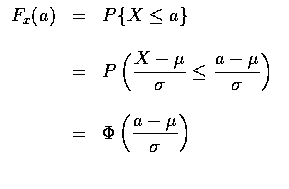The Standard Normal Distribution
An important fact about normal random variables is that if X is normally
distributed with parameters ![]() and
and ![]() ,
then
,
then
![]() is
normally distributed with parameters
is
normally distributed with parameters
![]() and
and
![]() .
This follows because FY, the cumulative distribution function of the
random variable Y, is given, when
.
This follows because FY, the cumulative distribution function of the
random variable Y, is given, when ![]() ,
by
,
by
![$\begin{array}{rcl}
F_Y(a)&=&P\{Y\leq a\} \\ \\
&=&P\{\alpha X +\beta\leq a\} \...
...-\frac{[y-(\alpha\mu+\beta)]^2}{2\alpha^2\sigma^2}\right\}dy \\ \\
\end{array}$](img7.gif)
Since,
 ,
that the probability density
function of Y, FY(y), is given by
,
that the probability density
function of Y, FY(y), is given by
![$\displaystyle f_Y(y)=\frac{1}{\displaystyle\sqrt{2\pi}\alpha\sigma}
\exp\left\{-\frac{[y-(\alpha\mu+\beta)]^2}{2\alpha^2\sigma^2}\right\}dy$](img9.gif)
If X is normally distributed with parameters ![]() and
and ![]() ,
then
,
then
![]() is normally distributed with parameters 0 and 1. Such a
random variable Z is said to have the standard, or
unit, normal distribution. It is traditional to denote the
cumulative distribution function of a standard normal random variable by
is normally distributed with parameters 0 and 1. Such a
random variable Z is said to have the standard, or
unit, normal distribution. It is traditional to denote the
cumulative distribution function of a standard normal random variable by

If Z is a standard normal random variable, then
